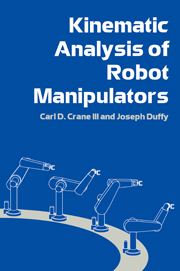Book contents
- Frontmatter
- Contents
- Preface
- 1 Introduction
- 2 Coordinate transformations
- 3 Manipulator kinematics
- 4 Forward kinematic analysis
- 5 Reverse kinematic analysis problem statement
- 6 Spherical closed-loop mechanisms
- 7 Displacement analysis of group 1 spatial mechanisms
- 8 Group 2 spatial mechanisms
- 9 Group 3 spatial mechanisms
- 10 Group 4 spatial mechanisms
- 11 Case studies
- 12 Quaternions
- Appendix
- References
- Index
7 - Displacement analysis of group 1 spatial mechanisms
Published online by Cambridge University Press: 12 September 2009
- Frontmatter
- Contents
- Preface
- 1 Introduction
- 2 Coordinate transformations
- 3 Manipulator kinematics
- 4 Forward kinematic analysis
- 5 Reverse kinematic analysis problem statement
- 6 Spherical closed-loop mechanisms
- 7 Displacement analysis of group 1 spatial mechanisms
- 8 Group 2 spatial mechanisms
- 9 Group 3 spatial mechanisms
- 10 Group 4 spatial mechanisms
- 11 Case studies
- 12 Quaternions
- Appendix
- References
- Index
Summary
Introduction
A group 1 spatial mechanism was defined in Chapter 6 as a one-degree-of-freedom closed-loop kinematic chain with one link, the frame, fixed to the ground and whose equivalent spherical mechanism also has one degree of freedom. All the mechanism dimensions, the link lengths and twist angles, are assumed to be known at the outset. Also, the offset (joint angle) of each revolute (prismatic) joint connecting a pair of links that in general are skew is assumed to be known. The joint angle of a revolute pair (the input pair) connecting a link (the input link) to the frame is assumed to be known.
It will be seen in this chapter that the analysis of all group 1 spatial mechanisms can proceed by first determining the unknown joint parameters from sine, sine–cosine, and cosine laws for the equivalent spherical mechanism, which is essentially a spherical four-link mechanism because there can be no relative motion on a sphere of a pair of links connected by a prismatic joint. The remaining unknown displacements will then be determined from writing the vector loop equation for the mechanism and projecting this equation onto three linearly independent directions, which yields three scalar equations in three unknown displacement values. Two example mechanisms will be presented in this chapter followed by an analysis of the CCC spatial robot manipulator.
RCPCR mechanism
Figure 7.1 shows an RCPCR group 1 spatial mechanism and its equivalent spherical mechanism. Figure 7.2 shows a planar representation of the same mechanism.
- Type
- Chapter
- Information
- Kinematic Analysis of Robot Manipulators , pp. 92 - 105Publisher: Cambridge University PressPrint publication year: 1998



